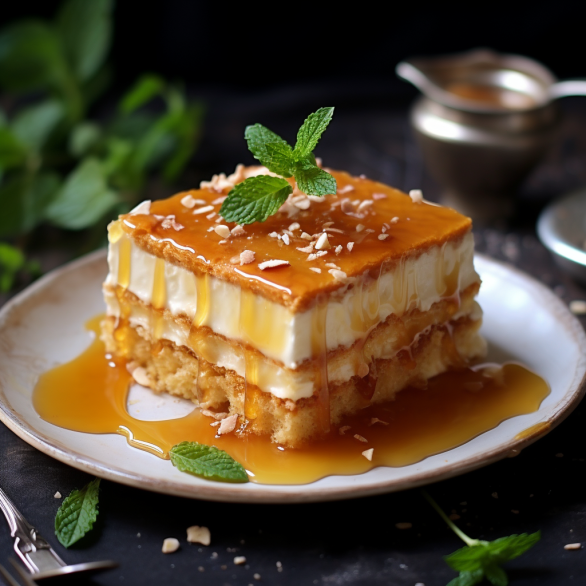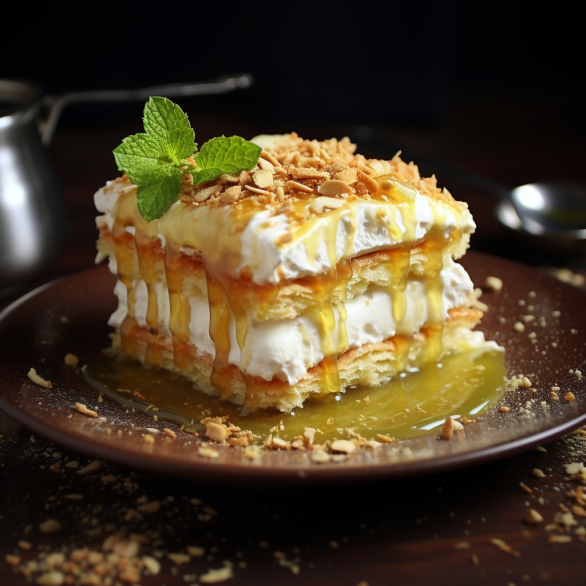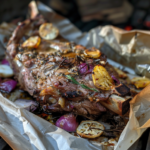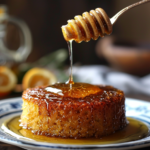Are you ready to experience a burst of flavors in your mouth? The Greek Kataifi dessert is here to tantalize your taste buds. The Greek Kataifi dessert is made by baking shredded pastry until it is crispy and golden. Once you bite into it, you will discover a sweet and rich filling that will have you wanting more. Whether you’re a dessert enthusiast or simply looking to satisfy your sweet tooth, the Greek Kataifi is a must-try delicacy that will transport you to the streets of Greece. So, grab a fork and get ready to indulge in the irresistible flavors of this heavenly dessert.

What is Greek Kataifi?
Greek Kataifi is a delectable shredded pastry dessert that originates from Greece. It is a popular sweet treat made from a special kind of dough that is shredded into thin strands, resembling vermicelli or shredded wheat. These strands are then layered or rolled with various fillings, such as nuts, cheese, or sweet syrup, to create a mouthwatering dessert. Greek Kataifi is known for its unique texture and delicate, flaky appearance, making it a truly delightful dessert.
Origins of Greek Kataifi
Greek Kataifi has a long and rich history, dating back to ancient Greece. The word “kataifi” originates from the Arabic word “kataf,” which means “shredded.” It is believed that the techniqe of shredding dough was introduced to Greece during the Ottoman Empire’s rule, and it quickly became a beloved dessert in Greek cuisine. Over the years, Greek Kataifi has become a symbol of celebration and is often served during festivals, weddings, and other special occasions.
Ingredients used in Greek Kataifi
The key ingredient in Greek Kataifi is the special dough, which is made from flour, water, and olive oil. It is this dough that is shredded into thin strands to create the unique texture of Kataifi. The filling for Greek Kataifi varies depending on the desired taste and can range from sweet to savory. Sweet variations often include a mixture of finely chopped nuts, sugar, cinnamon, and sometimes a touch of honey or syrup. Savory variations may use cheese, such as feta, mixed with herbs and spices. Furthermore, butter or clarified butter is used to brush the dough layers, enhancing the flavor and creating a crisp golden crust.
Texture and appearance of Greek Kataifi
Greek Kataifi is known for its delicate appearance and unique texture. The shredded dough strands create a beautiful and intricate nest-like shape after baking, which adds to the visual appeal of the dessert. The thin strands of dough turn crispy and golden on the outside, while remaining soft and moist on the inside. The combination of the crisp exterior and the moist interior provides a delightful contrast of textures. The fillings, whether it be nuts, cheese, or syrup, add another layer of flavor and texture, making Greek Kataifi a truly satisfying dessert.
Traditional Greek Kataifi Recipe
Preparing the dough for Greek Kataifi requires a few simple steps. First, a basic dough is made by combining flour, water, and olive oil, which is then kneaded until it becomes smooth and elastic. The dough is then rolled out into a thin sheet. Using a special tool known as a “kataifi machine” or a pasta machine, the dough sheet is passed through the machine, which shreds it into thin strands. Alternatively, the dough can be shredded by hand using a fork or a pastry comb. Once the dough strands are ready, they can be used to assemble the dessert.
Preparing the filling is the next step in making Greek Kataifi. For a sweet version, a mixture of finely chopped nuts, sugar, cinnamon, and optional honey or syrup is prepared. For a savory version, cheese, such as feta, is crumbled and mixed with herbs and spices of choice. The filling is then evenly spread over the shredded dough, leaving some space at the edges for sealing.
Assembling the dessert is done by rolling or layering the shredded dough with the prepared filling. For a rolled kataifi, a portion of the shredded dough is placed on a flat surface, the filling is added, and the dough is tightly rolled to enclose the filling. For a layered kataifi, the shredded dough is spread in a baking dish, with layers of filling added in between. The process is repeated until the desired quantity is achieved.
Baking the Greek Kataifi is the final step in the traditional recipe. The assembled dessert is placed in a preheated oven and baked until the shredded dough turns golden brown and crispy. The baking time may vary depending on the size and thickness of the kataifi, but it usually takes around 30-45 minutes. Once baked, the Greek Kataifi is allowed to cool slightly before serving, as it is best enjoyed warm.
Variations of Greek Kataifi
Greek Kataifi offers a variety of delicious variations that cater to different taste preferences. Here are a few popular variations:
Syrup-based Kataifi
In this version, the shredded dough is layered or rolled with a sweet syrup made from sugar, water, and lemon juice. The syrup is poured over the baked kataifi, allowing it to absorb the delicious flavors. This variation adds a sticky and sweet element to the dessert, making it even more irresistible.
Nut-filled Kataifi
One of the most common variations of Greek Kataifi is the nut-filled version. Finely chopped nuts, such as walnuts, almonds, or pistachios, are mixed with sugar, cinnamon, and sometimes a touch of honey. This sweet and crunchy filling adds a delightful texture and flavor to the kataifi.
Cheese-filled Kataifi
For those who prefer a savory option, cheese-filled kataifi is a popular choice. Feta cheese is crumbled and mixed with herbs, such as mint or oregano, along with spices like black pepper. The cheese filling is then layered or rolled with the shredded dough and baked to perfection. This savory variation offers a delightful combination of flavors and textures.
Other Delicious Greek Desserts
While Greek Kataifi is a truly exceptional dessert, Greek cuisine boasts a range of other delectable sweet treats. Here are a few worth mentioning:
Baklava
Baklava is one of the most famous and beloved Greek desserts. It consists of layers of thin phyllo pastry, filled with a mixture of finely chopped nuts and sweetened with a syrup made from honey, lemon juice, and cinnamon. The layers are baked to a golden crispness and then generously drizzled with the syrup, resulting in a sweet and sticky delight.
Loukoumades
Loukoumades are fluffy, deep-fried dough balls soaked in sweet syrup and sprinkled with cinnamon and crushed walnuts. They are often served warm and are a popular street food in Greece. These bite-sized treats are incredibly addictive and are perfect for satisfying your sweet tooth.
Galaktoboureko
Galaktoboureko is a traditional Greek dessert made with layers of crispy phyllo pastry and a creamy custard filling. The custard is typically flavored with vanilla or lemon zest, giving it a delicate and refreshing taste. The dessert is baked until golden and then coated with a syrup to add sweetness and moisture.
Tips for Making the Perfect Greek Kataifi
To ensure your Greek Kataifi turns out perfectly every time, here are some handy tips to keep in mind:
Handling the Kataifi dough
When working with the kataifi dough, it is important to keep it covered with a damp cloth to prevent it from drying out. This will ensure that the dough remains pliable and easy to work with. Additionally, using a light hand when handling the dough strands will help preserve their delicate texture.
Choosing the right ingredients
Choosing fresh and high-quality ingredients is crucial for the success of your Greek Kataifi. Opt for the best nuts, such as walnuts or almonds, for the filling, and use authentic Greek cheese, such as feta, for the savory variation. When it comes to the syrup, using pure honey and freshly squeezed lemon juice will elevate the flavors of the dessert.
Baking and serving suggestions
To achieve a perfectly golden brown crust, preheat your oven before baking the Greek Kataifi. Additionally, brushing the assembled dessert with melted butter or clarified butter will enhance the flavor and contribute to the crispy texture. Once baked, allow the kataifi to cool slightly before serving, as it is best enjoyed warm. Dust the top with powdered sugar and sprinkle some finely chopped nuts for an extra touch of elegance.
Greek Kataifi in Modern Cuisine
Greek Kataifi has not only gained popularity in traditional Greek cuisine but has also found its way into modern culinary creations. Here are a few ways in which Greek Kataifi is being used in modern cuisine:
Greek Kataifi in restaurants
Many Greek restaurants around the world have included Greek Kataifi on their dessert menus. Chefs are coming up with creative ways to incorporate kataifi into their dishes, such as using it as a garnish or adding a twist to traditional desserts like cheesecakes or ice creams.
Greek Kataifi in fusion desserts
Greek Kataifi has become a favorite ingredient among pastry chefs for creating fusion desserts. It is being used to add a unique texture and flavor to dishes like crepes, tarts, and even macarons. These innovative desserts blend the traditional flavors of Greek Kataifi with other cuisines to create a delightful fusion of tastes.
Creative twists on traditional Greek Kataifi
Many home cooks and bakers are experimenting with Greek Kataifi and coming up with their own creative twists on the traditional recipe. Some may add chocolate, fruit, or even caramel to the filling, while others might use different types of nuts or cheeses. These variations allow for endless possibilities and encourage culinary exploration.
Health Benefits of Greek Kataifi
While Greek Kataifi is undoubtedly a treat for the taste buds, it is also worth mentioning some of the potential health benefits associated with this delicious dessert.
Nutritional value of Greek Kataifi
Greek Kataifi is a good source of carbohydrates and provides energy due to its high flour content. The nuts used in the filling are rich in healthy fats, protein, and essential minerals. However, it is important to note that kataifi should be consumed in moderation, as it is also high in calories and sugar.
Greek Kataifi as a source of energy
The combination of flour, nuts, and sugar in Greek Kataifi provides a quick source of energy, making it an ideal dessert for those needing a pick-me-up. The carbohydrates from the flour, along with the fats and protein from the nuts, help sustain energy levels and keep you feeling satisfied.
Including Greek Kataifi in a balanced diet
Greek Kataifi can be enjoyed as part of a balanced diet when consumed in moderation. Pairing it with nutritious ingredients, such as fresh fruits or a side of Greek yogurt, can add additional vitamins, minerals, and fiber to your dessert. As with any indulgence, it is important to practice portion control and maintain a varied and balanced diet overall.
Greek Kataifi: A Symbol of Celebration
Greek Kataifi holds a significant place in Greek culture and is often associated with celebrations and special occasions. Let’s explore some of the ways in which Greek Kataifi is used in various festivities:
Kataifi in Greek festivals and events
Greek festivals and events are incomplete without the presence of Greek Kataifi. It is a staple dessert that is served during religious festivals, local celebrations, and cultural gatherings. The delicate and delightful nature of Greek Kataifi perfectly complements the festive atmosphere and adds to the joyous spirit of these events.
Greek Kataifi as a traditional dessert for weddings
Greek weddings are known for their vibrant celebrations and delicious feasts. Greek Kataifi often takes center stage as one of the traditional desserts served at these joyous occasions. The sweet and rich flavors of the kataifi symbolize prosperity and happiness, making it a must-have dessert at Greek weddings.
Celebrating special occasions with Greek Kataifi
Whether it’s a birthday, anniversary, or any other special occasion, Greek Kataifi often makes an appearance to mark the festivities. Its intricate appearance and delectable taste make it a fitting dessert to celebrate life’s most cherished moments with family and friends.
Where to Find Greek Kataifi
If you find yourself craving Greek Kataifi, there are several places where you can satisfy your sweet tooth:
Greek pastry shops and bakeries
Greek pastry shops and bakeries are the best places to find authentic Greek Kataifi. These establishments specialize in Greek desserts and pastries, and their expert bakers can craft the perfect kataifi for you to enjoy. Look for shops that are known for their traditional recipes and quality ingredients for an authentic Greek experience.
Online stores for Greek desserts
With the rise of online shopping, it is now possible to find Greek Kataifi and other Greek desserts available for delivery worldwide. Many online stores offer a wide range of Greek delicacies, allowing you to get your hands on a box of delicious kataifi delivered right to your doorstep.
Making your own Greek Kataifi at home
For those who prefer a hands-on approach, making Greek Kataifi at home can be a rewarding experience. With the right ingredients and a bit of practice, you can create your own batch of this delectable dessert. There are many recipes and video tutorials available online that can guide you through the process, helping you achieve the perfect homemade Greek Kataifi.
Conclusion
Indulge in the irresistible delight of Greek Kataifi, a shredded pastry dessert that will transport your taste buds to Greece. With its delicate texture, unique appearance, and mouthwatering fillings, Greek Kataifi offers a truly delightful experience. Whether you choose the classic nut-filled version or opt for a syrup-based or cheese-filled variation, this dessert is sure to satisfy your sweet cravings. As you explore the world of Greek desserts, don’t forget to try other classic treats like baklava, loukoumades, and galaktoboureko. With their wonderful flavors and cultural significance, these desserts will take you on a culinary journey through Greece. Whether enjoyed in traditional celebrations or modern culinary creations, Greek Kataifi is a symbol of joy and a delicious way to celebrate life’s special moments. So go ahead, treat yourself to a slice of Greek Kataifi, and savor the sweet taste of Greece.
FAQ 1: What is Greek Kataifi?
Greek Kataifi is a unique dessert featuring thin strands of phyllo dough, similar to shredded wheat, typically filled with nuts and sweetened with a honey syrup. It’s a quintessential part of Greek gastronomy, offering a delightful texture contrast with its crunchy exterior and succulent interior. For an exploration of Greek desserts, check out the traditional Greek Mezes Recipe.
FAQ 2: How do I prepare traditional Greek Kataifi?
Preparing traditional Greek Kataifi involves wrapping the delicate strands of dough around a nutty filling, often a mixture of chopped walnuts, cinnamon, and sugar, then baking until golden. After baking, a sweet syrup made from honey or sugar is poured over the kataifi to add moisture and sweetness. Learn more about Greek pastry techniques and recipes with Chef on a Bike on YouTube.
FAQ 3: Can Greek Kataifi be made in advance?
Yes, Greek Kataifi can be prepared in advance. You can assemble the dessert and keep it refrigerated before baking, or you can bake it and store it at room temperature for a few days, ensuring it retains its texture and flavor. For a comprehensive guide on preparing and preserving Greek desserts, enhance your culinary skills with a Greek Breakfast that showcases the versatility of Greek pastries.
FAQ 4: Where can I find authentic Greek Kataifi recipes?
Authentic Greek Kataifi recipes can be found on platforms that celebrate Hellenic culinary arts. Sponsored by Digital Heroes Caffe and Financial Navigator 360, these platforms offer a deep dive into Greek cuisine with a collection of recipes, cooking tips, and cultural insights. Delve into the heart of Greek baking with Greek Mornings for recipes that bring the essence of Greece to your table.






















